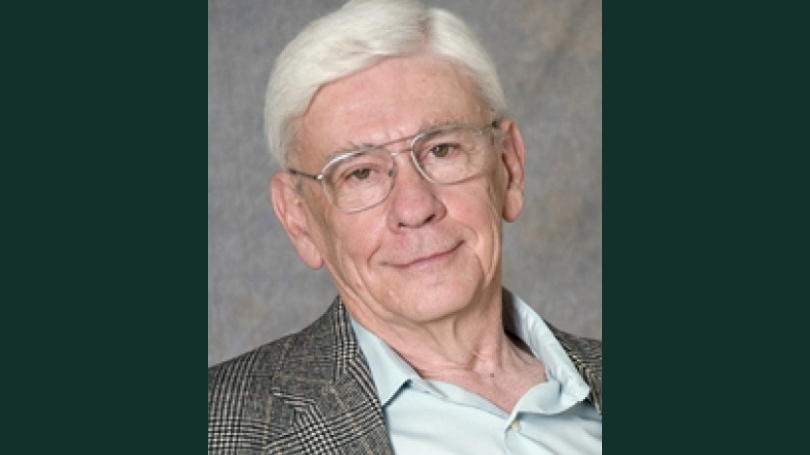
- About
- Departments & Programs
- Faculty Resources
- Governance
- Diversity
- News
Back to Top Nav
Back to Top Nav
Back to Top Nav
Back to Top Nav
The internationally recognized expert in plasma physics died on Dec. 12.
David Montgomery, Eleanor and A. Kelvin Smith Professor Emeritus of Physics, died on Dec. 12 from complications of Parkinson's disease. He was 87.
"An internationally recognized expert in plasma physics, David was an intellectual powerhouse who made significant advances in some of the most challenging areas of his field," Dean Elizabeth F. Smith wrote in a message to the Arts and Sciences community. "Over the course of his more than two decades at Dartmouth, he inspired countless students and colleagues with his extraordinary intellect and integrity. He will be deeply missed."
"David was one of the most talented theorists of his generation," says professor James LaBelle, chair of the Department of Physics and Astronomy. "He did pioneering research in both kinetic theory and magnetohydrodynamics, applied to both laboratory and space plasmas."
Montgomery was born on March 5, 1936, in Milan, Missouri. He received his BS from the University of Wisconsin, Madison in 1956 and completed his PhD in physics at Princeton University in 1959, under the guidance of professor Lyman Spitzer. He published his field-defining first book, Plasma Kinetic Theory, with Derek Tidman in 1964. Physics Today praised the book as a "quantum jump in difficulty from the existing books on plasma physics." His second book, The Theory of the Unmagnetized Plasma, came out in1971.
A prolific scholar and author, Montgomery published nearly 200 papers in peer-reviewed scientific journals over the course of his career. In the 1970s, he began working on fluid physics and magnetohydrodynamics, areas that were enhanced for decades by his major contributions. His papers frequently garnered hundreds of citations, and one paper on anisotropy became the single most cited paper in the history of the Journal of Plasma Physics.
After research scientist appointments at Princeton University, the University of Maryland, and University of Wisconsin, Montgomery joined the faculty of the University of Iowa in 1965 before moving to the College of William and Mary in 1977. He arrived at Dartmouth in 1984 as a tenured full professor, and was promoted to the Eleanor and A. Kelvin Smith Professor of Physics in 1988.
Between 1978 and 1980, Montgomery led the NASA Plasma Turbulence Explorer Study Group, which worked to articulate requirements for a multi-spacecraft mission that would characterize plasma turbulence in space. The NASA HelioSwarm mission, now slated for a 2028 launch, will represent the realization of his vision.
Montgomery enjoyed teaching and was proud of the accomplishments of his former students, many of whom went on to successful careers in physics. He supervised 22 PhD theses and more than 20 postdoctoral scholars, and taught numerous undergraduate and graduate physics classes at all levels. Montgomery was also in demand as a speaker and gave many invited talks at prestigious institutions, including Les Houches and the National Center for Atmospheric Research.
In 1996, to commemorate Montgomery's 60th birthday, the Journal of Plasma Physics published a special issue on nonlinear plasma physics, a topic he pioneered. So many papers were submitted that the issue was published in two parts. That same year, Montgomery received an honorary doctoral degree from the Technical University of Eindhoven for his work in two-dimensional hydrodynamics and magnetohydrodynamics.
Montgomery held visiting teaching and research appointments at more than 20 universities and laboratories around the world, including the University of Wisconsin, Columbia University, New York University, Hunter College, University of California, Berkeley, University of Colorado, Utrecht University (Netherlands), Culham Laboratory (Oxford, UK), Technical University of Eindhoven (Netherlands), Heinrich-Heine University (Germany), Risøe National Laboratory (Denmark), and Nagoya University (Japan). He also held consultant appointments at NASA Goddard Space Flight Center, NASA Langley Research Center, Los Alamos National Laboratory, and Oak Ridge National Laboratory. He was named a fellow of the American Physical Society in 1969.
Among his many friends and colleagues, Montgomery was known for his numerous and far-ranging interests. He cared deeply about social justice issues and the environment. He also loved art, music, and literature, and outdoor activities such as hiking, canoeing, and badminton.
He took pleasure in working with colleagues from other countries and discussing politics and local customs with them. Drawing upon his multicultural experiences, he delivered a paper and published an essay later in life, "Can a physical scientist contribute significantly to the cause of peace?" (2006), exploring a topic close to his heart.
Montgomery is survived by his wife of 66 years, Shirley; his daughters, Elizabeth Montgomery and Kathleen Montgomery Sutton; and two grandchildren. A memorial service will be held at Kendal at Hanover on Saturday, Jan. 20, at 3 p.m.